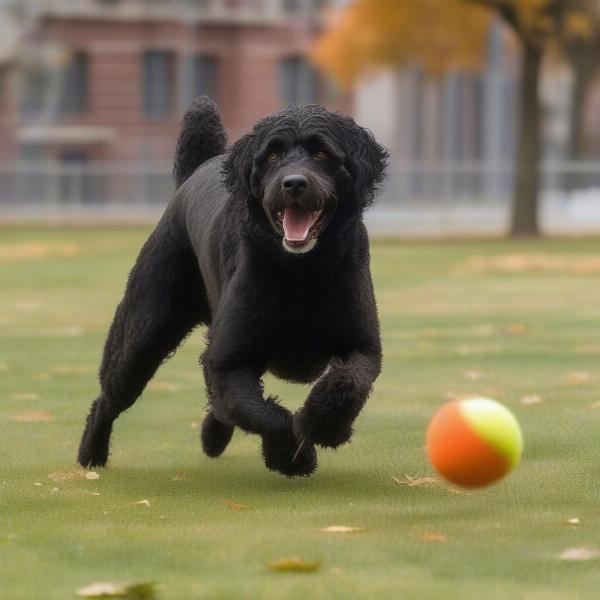The Portuguese Water Dog Lab mix, often affectionately called the “Portador,” is a fascinating blend of two beloved breeds. This increasingly popular cross combines the intelligence and work ethic of the Portuguese Water Dog with the friendly, outgoing nature of the Labrador Retriever. Are you considering adding a Portador to your family? This guide will delve into everything you need to know about this unique mix, from temperament and training to health and grooming.
 Portuguese Water Dog Lab Mix playing fetch
Portuguese Water Dog Lab Mix playing fetch
Temperament and Personality of a Portador
What kind of personality can you expect from a Portuguese Water Dog Lab mix? Generally, they inherit a mix of traits from both parent breeds. Expect a dog that’s intelligent, eager to please, and highly trainable, thanks to the Labrador’s inherent love for learning. The Portuguese Water Dog contributes to their playful and sometimes mischievous nature. They’re also likely to be affectionate and bond strongly with their family, making them excellent companions for both adults and children. However, their Portuguese Water Dog heritage can sometimes mean they’re a bit wary of strangers, so early socialization is crucial.
Training and Exercise Needs
Both parent breeds are energetic and require regular exercise. Therefore, a Portuguese Water Dog Lab mix will need plenty of physical activity to stay happy and healthy. Daily walks, runs, swims, and playtime are essential. Their intelligence makes them quick learners, but their playful streak can sometimes lead to distractions. Positive reinforcement methods work best, rewarding good behavior with praise and treats.
Is the Portuguese Water Dog Lab Mix Easy to Train?
Yes, the Portador’s intelligence and eagerness to please make them relatively easy to train. Consistency and patience are key, as with any breed. Starting training early is crucial, particularly focusing on socialization to ensure they’re comfortable around other dogs and people.
Health and Grooming
What Health Issues Can Affect a Portador?
While generally healthy, Portuguese Water Dog Lab mixes can be prone to certain health conditions common to their parent breeds, such as hip and elbow dysplasia, progressive retinal atrophy, and some heart conditions. Regular veterinary checkups and a healthy lifestyle can help mitigate these risks.
Grooming Your Portuguese Water Dog Lab Mix
The Portador’s coat can vary, from the Labrador’s short, dense fur to the Portuguese Water Dog’s curlier, non-shedding coat. Regardless of coat type, regular brushing is necessary to prevent matting and keep their skin healthy. Occasional baths will keep them looking and smelling their best.
Is a Portador Right for You?
The Portuguese Water Dog Lab mix can be a wonderful addition to an active family prepared to meet their exercise and training needs. Their playful, affectionate nature makes them ideal companions. Dr. Emily Carter, a renowned veterinarian specializing in canine behavior, says, “The Portador’s intelligence and trainability make them adaptable to various lifestyles, but they thrive in environments where they can receive plenty of physical and mental stimulation.” Their loyalty and love for their families are undeniable. Remember, early socialization and consistent training are crucial for a well-adjusted and happy Portador.
Conclusion
The Portuguese Water Dog Lab mix offers a unique blend of charm, intelligence, and energy. This guide provides a starting point for understanding this fascinating crossbreed. With the right care and training, a Portador can bring years of joy and companionship to your family. Considering their activity levels and potential health considerations, proactive research and responsible ownership are crucial for ensuring a happy and healthy life for your Portador.
FAQ
- How big do Portuguese Water Dog Lab mixes get? They typically reach 17-24 inches in height and weigh between 40-65 pounds.
- Are they good with children? Generally, yes, they are known to be affectionate and playful with children, but early socialization is essential.
- Do they shed a lot? Their coat type can vary, impacting shedding. Some may shed minimally, while others shed moderately.
- How much exercise do they need? They are an energetic breed requiring significant daily exercise, including walks, runs, and playtime.
- Are they easy to train? Their intelligence makes them relatively easy to train, but consistency and positive reinforcement are key.
- What is their lifespan? They typically live between 10-14 years.
- Are they good with other dogs? With proper socialization, they can get along well with other dogs.
About ILM Dog: ILM Dog is your trusted source for comprehensive information on dog breeds, care, and training. We offer expert advice on everything from choosing the right breed to ensuring their health and well-being. Whether you’re a seasoned dog owner or considering welcoming your first puppy, ILM Dog has the resources you need. Contact us via email at [email protected] or by phone at +44 20-3965-8624 for expert advice and personalized guidance.